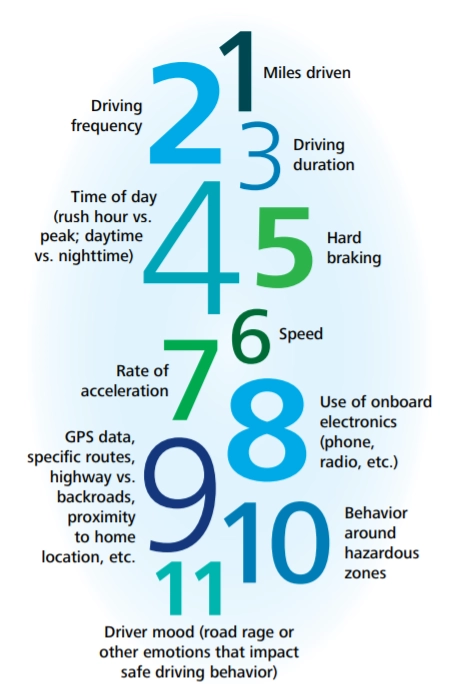The rapid growth of IoT is transforming the insurance industry by enabling continuous monitoring, which could prevent risks and reduce the need for traditional insurance.1 However, it also introduces challenges like cyber threats, making cyber risk insurance a potential focus. Since insurance relies heavily on data, IoT’s ability to increase data availability offers efficiency benefits.
Explore 6 key areas where IoT will impact the insurance sector, helping executives prepare for the future:
1. Better knowledge of customers behavior
Internet of things (IoT) technology allows insurers to go beyond basic data like age or mileage. In car insurance, connected vehicles now provide real-time data on driving speed, frequent braking, typical routes, and even cell phone use. This detailed information helps insurance companies improve risk assessment and offer more accurate pricing.
Figure 1. New data sources for car insurers

Source: Deloitte2
2. Efficient claim processing
Claims processing is one of the most important operations in the insurance sector, impacting both customer satisfaction and insurance company profitability. The Coalition Against Insurance Fraud reports that fraudulent claims cost approximately $309 billion per year.3 On the customer satisfaction side, insurance customers expect quick responses.4 IoT improves both processes thanks to instant communication between devices.
Let’s look again at the case of car insurance to illustrate the positive impact of the IoT on claims processing. In the past, when a car accident occurred, the policyholder had to call the insurance company to fill out the first notice of loss (FNOL).
Depending on the extent of the accident, this process took some time. For example, the policyholder could pass out and not inform the insurance company quickly. The more delayed claims, the higher the probability of fraudulent claims as well as unsatisfied customers.
Today, claims processing is different. When airbags deploy, telemetry automatically alerts the insurance company. This speeds up the first notice of loss (FNOL) process, resulting in greater customer satisfaction and fraud protection.
3. Customized insurance practices
More data about customers means better risk assessment. As a result, insurance companies no longer need to divide people into risk categories to hedge their operational risks. For this reason, special customer insurance policies, known as pay-as-you-go (PAYG) policies, are being added to the menu of insurance companies.
PAYG premiums are calculated depending on the use of the insured items. One of the good examples, the more often you park your car, the less you pay for its insurance.
4. Fewer claims, fewer risks
The interconnectedness of smart devices and their rapid proliferation are eliminating some risks that have been insured for centuries due to the risk-averse nature of humans. This phenomenon could potentially threaten the future of the traditional insurance sector.
For example, we tend to insure our houses in the event of a fire. However, thanks to smart home technology, telematics can detect a gas leak and shut off the gas flow before a fire occurs. Similarly, a smart factory can monitor the performance of working machines and prevent loss before a disaster occurs, reducing the need for business insurance.
Thanks to the IoT, many risks can be identified and eliminated before they cause damage. Every insurance company naturally sets a price that supports making a profit. Still, the new, relatively risk-free world may mean that insurance companies do not add margin to the price of risk, forcing at least some of them to exit the market.
5. New insurance areas
It is true that the rapid increase in the number of connected smart devices is reducing some of the risks we used to face. However, it also introduces a systematic risk that can be insured against. The more people depend on smart devices, the more vulnerable they are to cyberattacks. Insuring against cyber risk would be the future of the insurance sector.
6. Increased data privacy and security concerns
A massive flow of data implies more information about customers’ personal lives. Consequently, the risk of data leaks, hacker attacks, and simply being persuaded to share data with insurance companies increases.
Privacy
While telematics captures data that helps insurance companies assess risk, it also likely captures other information that could be useful to companies in other industries or completely private to the customer. In such cases, data misuse can occur. The customer can become the target of personalized sales efforts that inevitably exploit their privacy and threaten everyone’s quality of life if the problem remains unresolved.
Security
The massive data collection thanks to the IoT also makes cyberattacks more likely because the return of hacking is greater. Consequently, ensuring data security will be both costly and an important issue for insurance companies.
It is important to know that many insurance companies outsource their IT services through cloud computing services, which reduces their IT expenses and their control over data and data security.
Especially with public clouds, data security is not adequately protected. As a result, the lower short-term cost of clouds that comes from not having to develop hardware can cost insurance companies more in the long run.
Convincing Customers
Ensuring data security is one thing; convincing customers is another. We live in a world of perceptions, and the truth is not always important or understandable. 47% of drivers believe they would not want to share their driving data under any circumstances, while 27% would consider sharing data in exchange for a discount. Additionally, 9% of respondents expect a discount of more than 20%.5
Benefits of IoT in the insurance sector
According to estimations of 2025, the insurance industry embodies IoT opportunities potential across nine key sectors.
Figure 3. Economic potential across nine key sectors
Source: McKinsey6
Here are some key benefits of IoT in the insurance sector:
1. Increased efficiency and resource optimization
- IoT enables insurers to streamline operations by leveraging real-time data, reducing administrative burdens, and improving claims processing.
- Sensor-driven decision analytics help optimize resource allocation and reduce operational costs.
2. Enhanced risk prevention and loss mitigation
- IoT-triggered maintenance mechanisms, such as predictive alerts for industrial equipment, help prevent costly failures.
- Smart water valves automatically shut off leaks to prevent extensive water damage, while IoT smoke detectors provide instant fire alerts.
- Motion sensors notify homeowners and businesses of unauthorized entry, enabling quick intervention and reducing theft risks.
3. Improved safety and faster emergency response
- IoT extends safety standards by enabling real-time emergency responses. For instance, automatic dispatch of ambulance services can be triggered immediately after an accident.
- Insurers can use connected health devices and wearables to monitor policyholders’ well-being and provide proactive interventions.
Read 40 IoT Applications & Use Cases with Real-Life Examples, for information on IoT applications used in insurance and other industries.
Reference Links

Cem's work has been cited by leading global publications including Business Insider, Forbes, Washington Post, global firms like Deloitte, HPE and NGOs like World Economic Forum and supranational organizations like European Commission. You can see more reputable companies and resources that referenced AIMultiple.
Throughout his career, Cem served as a tech consultant, tech buyer and tech entrepreneur. He advised enterprises on their technology decisions at McKinsey & Company and Altman Solon for more than a decade. He also published a McKinsey report on digitalization.
He led technology strategy and procurement of a telco while reporting to the CEO. He has also led commercial growth of deep tech company Hypatos that reached a 7 digit annual recurring revenue and a 9 digit valuation from 0 within 2 years. Cem's work in Hypatos was covered by leading technology publications like TechCrunch and Business Insider.
Cem regularly speaks at international technology conferences. He graduated from Bogazici University as a computer engineer and holds an MBA from Columbia Business School.



Comments 1
Share Your Thoughts
Your email address will not be published. All fields are required.
Insightful read. Throws light on the IoT's role in effecting the insurance sector...
Hello Alza Business! Thank you for your feedback. If you'd like to learn about other technologies transforming the insurance sector, we have other articles here: https://research.aimultiple.com/category/insurtech/